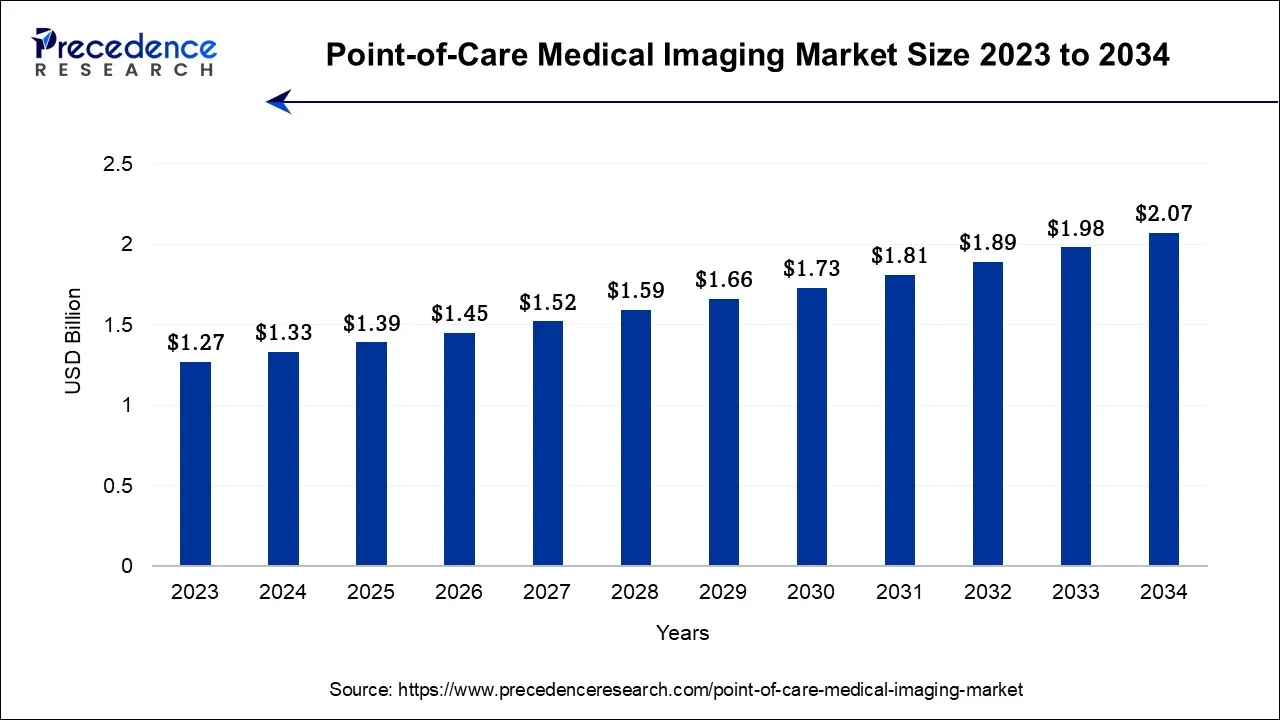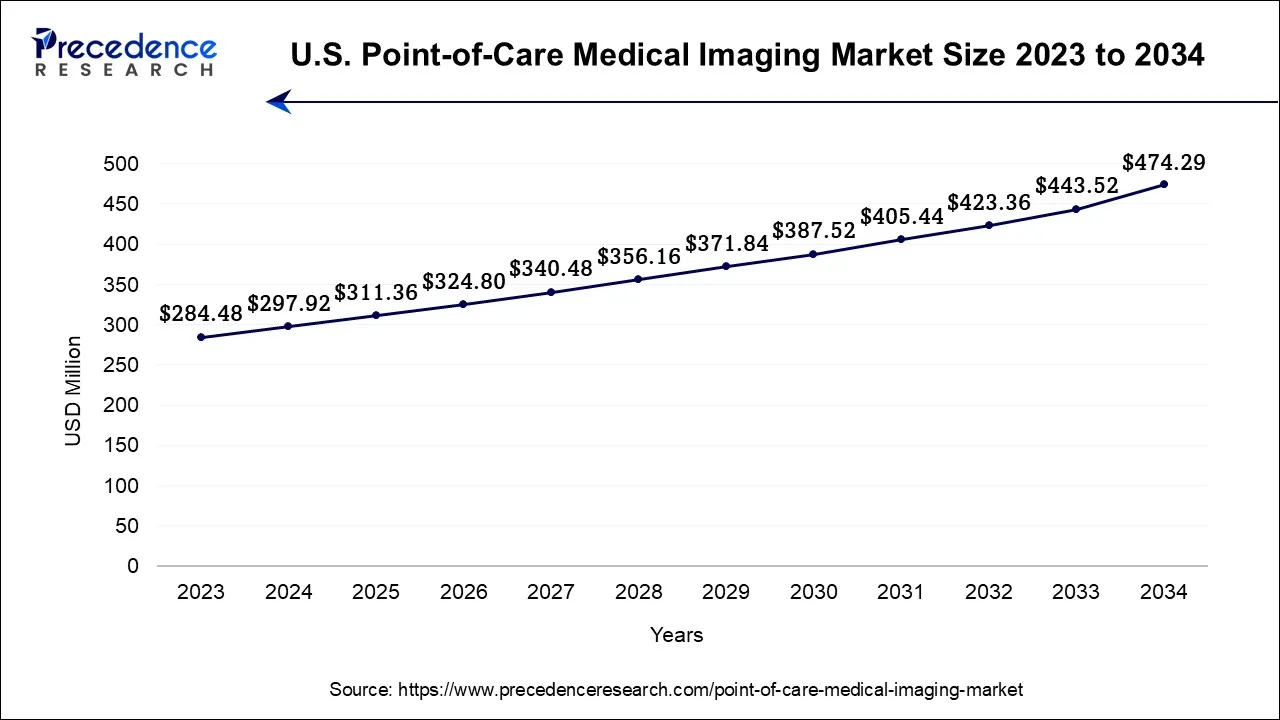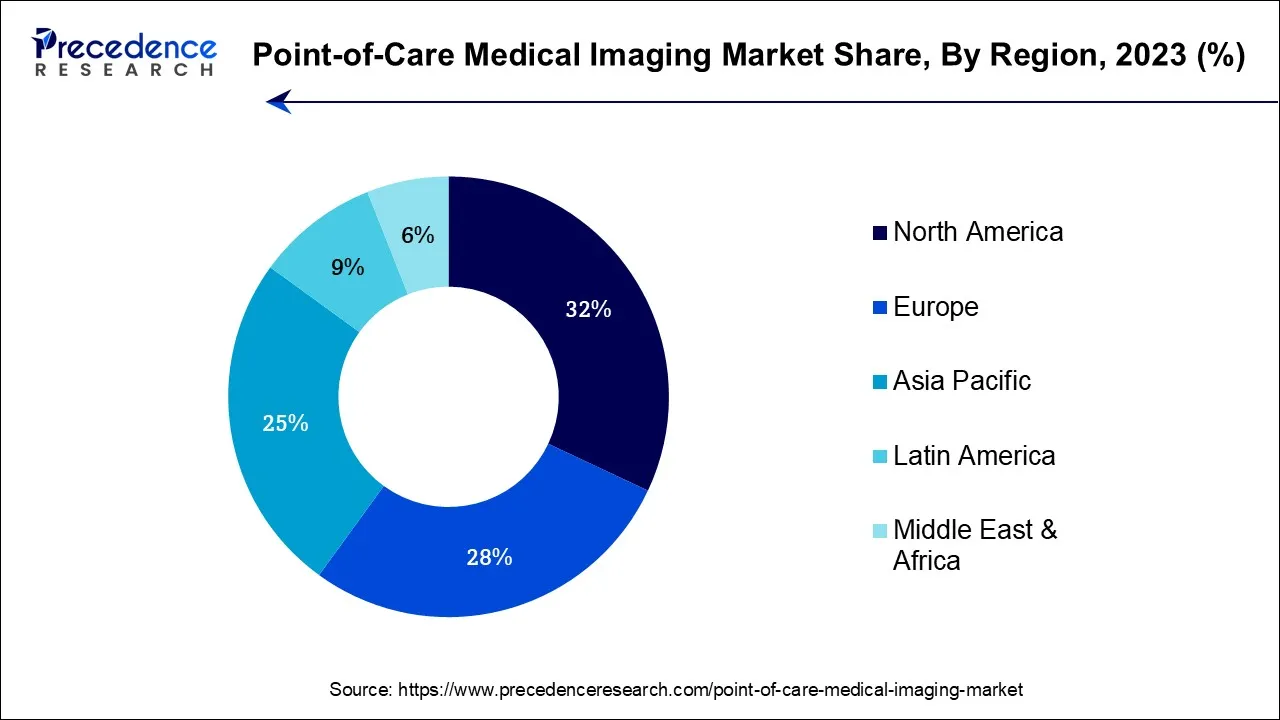Point-of-Care Medical Imaging Market Size and Forecast 2024 to 2034
The global point-of-care medical imaging market is expected to be valued at USD 1.33 billion in 2024 and is anticipated to reach around USD 2.07 billion by 2034, expanding at a CAGR of 4.52% over the forecast period from 2024 to 2034.

Point-of-Care Medical Imaging Market Key Takeaways
- North America contributed more than 33% of revenue share in 2023.
- By Product, the ultrasound segment dominated the market with the largest market share of 58% in 2023.
- By Application, the general imaging segment led the global market with the highest market share of 32% in 2023.
- By End-user, the hospital segment captured more than 44% of revenue share in 2023.
U.S. Point-of-Care Medical Imaging Market Size and Growth 2024 to 2034
The U.S. point-of-care medical imaging market size is accounted for USD 297.92 million in 2024 and is projected to be worth around USD 474.29 million by 2034, poised to grow at a CAGR of 4.76% from 2024 to 2034.

North America is expected to dominate the market over the forecast perioddue to its well-established healthcare systems and high adoption of advanced medical technologies. Moreover, the growing government initiatives are expected to offer an enormous opportunity in the regional market. For instance, in December 2022, to support the installation of 27 new magnetic resonance imaging (MRI) devices in hospitals around Ontario, the provincial government of Ontario contributed operational funds of more than $20 million. Additionally, the funding aims to help hospitals in high-growth areas with a growing population meet the rising demand for MRI services. More MRI services across the province would allow for quicker diagnosis and, if necessary, an earlier start to treatment and follow-up care for patients. Thus, the aforementioned facts drive the market growth in the region.

Asia Pacific is expected to grow at the highest CAGR during the forecast period.The market growth in the region is attributed to the rising prevalence of chronic diseases such as cancer, cardiovascular diseases and others. Asia Pacific region is home to a significant portion of the global population, and healthcare needs are diverse across countries with varying levels of economic development. The market for point-of-care medical imaging in Asia Pacific is expanding due to factors such as increasing healthcare investments, rising awareness of advanced medical technologies, and the need for efficient diagnostic solutions. Furthermore, many countries in Asia Pacific are investing in healthcare infrastructure and technology, creating a conducive environment for the adoption of point-of-care imaging solutions. Therefore, this is expected to drive market growth in the region.
Market Overview
Medical imaging is essential to contemporary healthcare because it allows doctors and healthcare providers to see into patients' bodies in order to create a variety of diagnoses. Imaging operations have historically been carried out in specialist radiology departments with huge, fixed equipment. Point-of-care medical imaging, on the other hand, is a result of how the field of medical imaging has developed to meet the demand for faster and more practical diagnostic tools. Point-of-care medical imaging is the use of portable imaging equipment at the patient's bedside or close to them, eliminating the need to take them to special imaging facilities.
By granting instant access to diagnostic data, especially in emergency circumstances, critical care settings, and areas with limited access to sophisticated medical equipment, this method revolutionizes the delivery of healthcare. The idea of point-of-care imaging is consistent with the more general trend of personalized medicine, where interventions and treatments are customized to the requirements of particular patients.
Point-of-Care Medical Imaging Market Growth Factors
Healthcare professionals may quickly begin recommending appropriate treatments and interventions by bringing imaging capabilities straight to the patient. The point-of-care medical imaging market is driven by various factors including the growing innovative product launches, the growing prevalence of chronic disease, the emergence of advanced technologies such as AI and ML, growing investment in healthcare infrastructure, growing populations, rising regulatory approvals, and increasing government initiatives.
Market Scope
| Report Coverage | Details |
| Market Size in 2024 | USD 1.33 Billion |
| Market Size by 2034 | USD 2.07 Billion |
| Growth Rate from 2024 to 2034 | CAGR of 4.52% |
| Largest Market | North America |
| Base Year | 2023 |
| Forecast Period | 2024 to 2034 |
| Segments Covered | By Product, By Application, and By End User |
| Regions Covered | North America, Europe, Asia-Pacific, Latin America, and Middle East & Africa |
Market Dynamics
Driver
Rise in chronic disease along with an increasing elderly population
The global increase in chronic diseases, such as cardiovascular diseases, diabetes, and cancer, has led to a higher demand for frequent and timely medical imaging. In addition, the elderly populations are more prone to chronic disease which rises the demand for on-the-spot diagnostic tools to manage and treat age-related health conditions.
For instance, according to the World Health Organization, with 17.9 million deaths per year, cardiovascular diseases (CVDs) are the leading cause of mortality worldwide. These numbers increase the demand for early diagnosis. Thus, the aforementioned facts support the market revenue growth during the forecast period.
Restraint
High cost
While point-of-care imaging devices offer convenience and rapid results, their initial acquisition cost and maintenance expenses can be relatively high. Healthcare institutions need to carefully evaluate the cost-effectiveness of these devices, particularly in resource-constrained settings. For instance, four large hospitals in Houston were surveyed on the cost of a head, chest, or abdomen computed tomography (CT), and the results ranged from $1,400 to $2,500. Thereby, hampering the market expansion over the forecast period.
Opportunity
Growing innovative product launch
The growing innovative product launch in the industry is expected to provide a lucrative opportunity for market growth over the forecast period. For instance, in August 2022, Mindray North America, a worldwide developer of healthcare technology for ultrasound, announced the launch of a new device that is changing perceptions in the Point of Care Ultrasound (POCUS) market, the TE X Ultrasound System. The portable TE X Ultrasound System offers a broad variety of cutting-edge solutions and AI-powered smart tools to ease clinical decision-making and assure reproducibility across examinations. Thus, the growing this kind of innovative product launch drives the revenue growth of the point-of-care medical imaging industry.
Product Insights
Based on the product, the global point-of-care medical imaging market is segmented into X-ray, CT and Ultrasound. The ultrasound segment is expected to dominate the market over the forecast period. Point-of-care ultrasound (POCUS) is created for the use of ultrasound technology at the patient's bedside or close to provide real-time imaging and diagnostics. It has gained immense popularity in various medical specialties due to its portability, convenience, and ability to offer immediate visual information for clinical decision-making. POCUS has transformed the way healthcare providers assess and manage patients in diverse medical settings, from emergency rooms and critical care units to outpatient clinics and remote locations.
Furthermore, the increasing product launches by the market players is expected to offer a significant opportunity for segment expansion during the analysis period. For instance, in July 2023, a new wireless portable ultrasound device, PocketPro H2 was launched by Konica Minolta Healthcare Americas, Inc. in order to get utilized in point-of-care applications for general imaging. Thereby, the rising requirement for portable ultrasound devices is observed to drive the segment's growth.
Application Insights
Based on the application, the global point-of-care medical imaging market is segmented into general imaging, cardiovascular, musculoskeletal and others. The general imaging segment is expected to capture the largest market share over the forecast period. General imaging refers to the use of medical imaging techniques to visualize various anatomical structures and diagnose a wide range of medical conditions. In the context of the point-of-care medical imaging market, general imaging includes technologies like X-ray, computed tomography (CT), and magnetic resonance imaging (MRI) that are used in a portable or compact form at the patient's bedside or in proximity. For instance, portable X-ray devices allow for quick visualization of bones and soft tissues. Thus, this is expected to drive the segment growth.
End User Insights
Based on the end user, the global point-of-care medical imaging market is segmented into hospitals, clinics and ambulatory surgical centers. The hospital segment is expected to grow at a significant rate over the forecast period. This expansion is attributable to an increase in patient visits necessitating computed tomography scans, a crucial component of hospital medical imaging due to the prevalence of neurological and respiratory diseases. The main purpose of installing CT imaging equipment in hospitals is to provide CT imaging to a sizable patient population.
The development of a portable point-of-care CT imaging gadget by market participants to speed up hospital operations by reducing patient transfers between departments is further boosting this market segment's growth.
Point-of-Care Medical Imaging Market Companies
- Philips Healthcare
- Siemens Healthineers AG
- GE Healthcare
- Samsung Medison
- Mindray
- FUJIFILM SonoSite, Inc.
- Neurologica
- Esaote
- Canon Medical Systems Corp.
- Xoran Technologies, LLC
Recent Developments
- In February 2023, at the 75th National Conference of the Indian Radiological and Imaging Association (IRIA), FUJIFILM India, a pioneer in healthcare imaging and information systems, announced the growth of its product and solution range. FUJIFILM India revealed cutting-edge diagnostic tools at the four-day conference that will take place in Amritsar from February 2–5, 2023. The new MRI machine APERTO Lucent Non-DICOM printer APEOS and the ultrasound systems Arietta 850 DeepInsight and Arietta 650 DeepInsight are all part of the new range. A smartphone application for service and support called "FUJIFILM Connect" was also released by the corporation.
- In November 2022, NIVIDIA and Nuance Communications announced that they are entering into a strategic cooperation or radiologists to have access to AI-based diagnostic tools. This aims to allow radiologists to offer better patient care at reduced costs.
Segments Covered in the Report
By Product
- X-ray
- CT
- Ultrasound
By Application
- General Imaging
- Cardiovascular
- Musculoskeletal
- Others
By End User
- Hospitals
- Clinics
- Ambulatory Surgical Centers
By Geography
- North America
- Europe
- Asia-Pacific
- Latin America
- Middle East and Africa
For inquiries regarding discounts, bulk purchases, or customization requests, please contact us at sales@precedenceresearch.com
Frequently Asked Questions
Ask For Sample
No cookie-cutter, only authentic analysis – take the 1st step to become a Precedence Research client
 sales@precedenceresearch.com
sales@precedenceresearch.com
 +1 804-441-9344
+1 804-441-9344